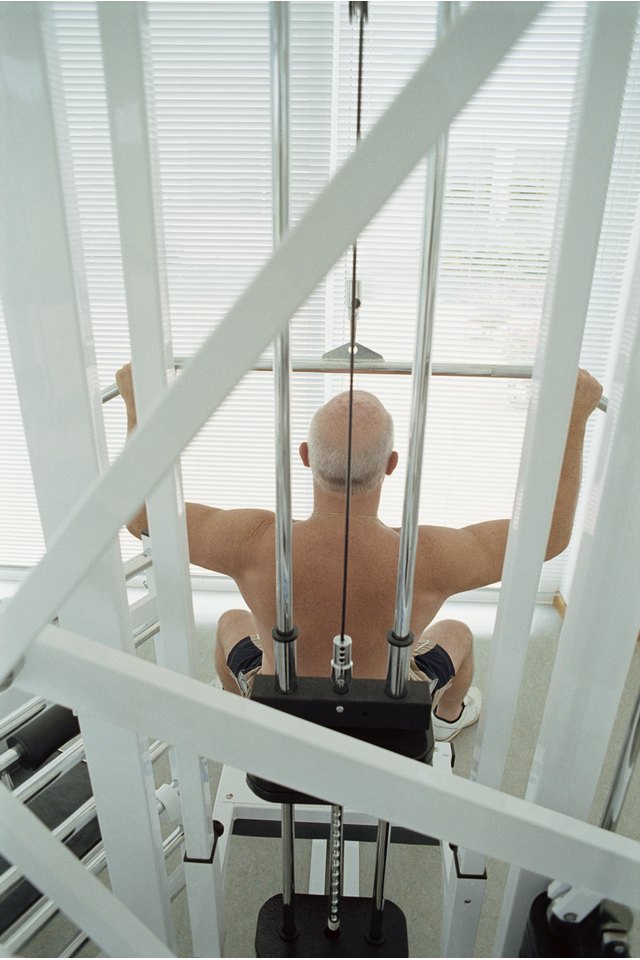What does fact checked mean?
At SportsRec, we strive to deliver objective content that is accurate and up-to-date. Our team periodically reviews articles in order to ensure content quality. The sources cited below consist of evidence from peer-reviewed journals, prominent medical organizations, academic associations, and government data.
The information contained on this site is for informational purposes only, and should not be used as a substitute for the advice of a professional health care provider. Please check with the appropriate physician regarding health questions and concerns. Although we strive to deliver accurate and up-to-date information, no guarantee to that effect is made.
Upper-Body Push Exercises: Difference between Push and Pull Exercises

Many gym goers fall victim to working the mirror muscles -- those muscles they see readily in their image -- and neglecting the ones they don't see. Lower body muscles like hamstrings, glutes, and more find themselves underworked as many choose to forego a full body workout. However, this is especially true when it comes to the upper body -- people overwork the chest, triceps, and biceps at the expense of the back and parts of the shoulder muscles. To maximize your weight workout, you need to address all the major muscles in your body. Emphasizing both push and pull exercises helps you work different muscle groups to create a balanced workout routine.
What are Push exercises?
Upper-body push exercises utilize weight training and generally use the muscles of the chest, front of the shoulders and backs of the arms. These exercises work your muscles as you extend the elbow joint. These exercises involve pushing weight away from your body during reps, or repetitions, to build muscle and maintain muscle growth. Push exercises are important to keeping that chest and shoulder complex strong and key to a good upper body workout.
What are the best push exercises?
Bench Press: The classic bodybuilding exercise, take a barbell with weight on it and lay flat on your back. Then use a personal trainer or partner to spot you as you move the weight to your chest and push it back to the top. Technique is very important here so be sure to keep your shoulders and glutes to the bench and only utilize your upper body, if this is too difficult try overhead press.
Push-ups: A classic strength training exercise, use your bodyweight to build muscle here. Simply get down on all fours using only your hands and feet to touch the ground. Lower yourself to the ground and push yourself off the ground.
Shoulder press: A classic for the deltoids, use two dumbbells for this one. Stand with feet at shoulder-width and keep the dumbbells at shoulder height with your elbows at a 90-degree angle. Lift the dumbbells as high as you can without straightening your arms fully. Then, pause at the top and slowly return to the start position.
Chest press: This can be done as a dumbbell chest press or with a machine. Start with arms at your sides, elbows bent and pointing out. Lift your arms above your chest and slowly lower your arms to your sides to the starting position. Mix in a chest fly to work the inner chest as well.
Tricep extensions/pushdown: This exercise can be two ways with a pushdown machine, or with a dumbbell. Have the weight behind your head and move it behind your neck slowly with your back straight. Bring it back up and down until completion.
Dumbbell lateral raise: Pick a couple of dumbbells and keep them by your sides. Lift the dumbbells out to your side until your arms are parallel to the floor then slowly lower to the start position.
What are pull exercises?
Upper-body pull exercises target the muscles of the upper and lower back, back of the shoulders and biceps. The muscles work as you make pulling movements toward your body. Examples of these are row type exercises or exercises that mirror a pullup. These are important muscles to workout despite the fact that they aren’t prominent.
What are good pull exercises?
Deadlift: A deadlift is a lift in which a weight is lifted from the floor to hip level. These come in many variations but in any exercise be sure to keep your torso to the ground and your glutes out like a squat.
Lat pulldown: Another great workout for upper back muscles, lat pulldown utilizes the lat pulldown machine. The bar will be at the top, grab both ends and pull it towards you while leaning back. It’s a simple exercise with great benefits.
Row: A row is another exercise with many variations, the most popular being barbell rows and bent-over row. The weight will be pulled towards your chest utilizing your back muscles, but form and technique depend on the variation
What is a push-pull workout?
A push-pull training day workout is a day in which a workout split between pull and push exercises are done. However many choose to split this day into two days, a push day and a pull day. This allows for more focus on the individual movement patterns but is not required. Be sure to mix in a cardio day and rest day in between these workouts.
References
Writer Bio
Andrea Cespedes is a professionally trained chef who has focused studies in nutrition. With more than 20 years of experience in the fitness industry, she coaches cycling and running and teaches Pilates and yoga. She is an American Council on Exercise-certified personal trainer, RYT-200 and has degrees from Princeton and Columbia University.
